Ever since my trip to Azerbaijan in the winter of 2018, I’d been wanting to return to the Caucasus region, so when Covid-19 finally slowed down over the autumn and I’d received my two vaccines on top of a recovery, I felt it was finally safe to go. I chose to fly into Tbilisi, the capital of Georgia, and out of Yerevan, the capital of Armenia. With 2,5 weeks to spare for the trip, I knew it wasn’t going to be enough to see everything these two magnificent countries have to offer, but at least I’d get a good taste of both – or so I thought. Because I actually ended up spending most of my time in Georgia and had just one afternoon to spare for Yerevan. The reason for that lies in Tbilisi and the amazing people I met there, but also in how gorgeous Georgia is. I just couldn’t get myself to rush through it.
I arrived at 4 AM in Tbilisi International Airport, exhausted after a most uncomfortable sleep in the plane (seriously, it’s so hard to breathe when sleeping with a mask!). I’d also had hardly any food as both Frankfurt Airport and Munich Airport where I had layovers had run out of vegan food, so I had to survive on pretzels which I don’t really like (sorry, Germans!). And in Tbilisi Airport nothing was open (thanks, Covid!). I took out some cash in the local currency (Georgian lari) and tried to find some info on the public bus. I was told that it wouldn’t be running until the morning (again, thanks to Covid), so I looked around for a fellow backpacker to share a cab with, and that’s how I met Yente from Belgium.
Lucky for me, his friend had already ordered him a taxi for just 17 lari, a huge difference from the 40+ lari rides the drivers at the airport were offering. Safe and sound, I finally got to my hostel around 5 AM. I had booked three nights at Envoy Hostel, but that didn’t include the rest of the night of my arrival (bad planning on my part). Thankfully, the receptionists said I could just go to the rooftop and sleep there while waiting to check in. I was surprised to discover the most incredible rooftop terrace with possibly the best view in all of Tbilisi! And there was even a nice soft sofa for me to fall asleep in. The night was warm so I slept like a baby and didn’t wake up until 11 AM the next morning!




To Liberty Square and Rustaveli Avenue
Tbilisi (or Tiflis as it’s still called by some, it’s pre-1936 name) is not only the capital, but also the largest city in Georgia, home to approximately 1,5 million people. Tbilisi feels like a perfect merge of Europe and Asia, owing to its history of being a point of contention on ancient international trade routes.
Tbilisi’s complex history in the periphery of the Silk Road is reflected in its architecture which is a broad mix of medieval, neoclassical, Art Nouveau, Stalinist and modern styles. The city is deeply fascinating, and one could spend weeks just wandering the streets and discovering all the architectural gems.
Half-starved, I took a much-needed shower, got myself ready for the day, checked in and then headed into the city to find some food. On the map, I’d spotted a cafe called Kiwi Vegan Café. At the time, I had zero idea about Georgian cuisine and just assumed that vegan food wasn’t really a thing (I couldn’t have been more wrong), so I decided to play it safe. The food was nothing special, but they had a great green smoothie and the most adorable cat that the employees had adopted from the streets.
On my way to the café, I walked past the Liberty Square, a focal point in the city and a symbol of the Georgian struggle for independence (a struggle that is still very real with the annexations of Abkhazia and South Ossetia by Russia).


With my stomach finally full, I headed back to Liberty Square and took a stroll along the fancy Rustaveli Avenue that begins there. Along the street are several touristic sights such as the National Museum of Georgia, the Parliament of Georgia, the Kashveti Church of St. George from the early 20th century, the exquisite Tbilisi Opera and Ballet State Theatre, and I also came across a small craft market.
I also visited a Magti shop to get myself a Georgian simcard. I paid just 13 lari (ca. 26 DKK) for two weeks of unlimited data!
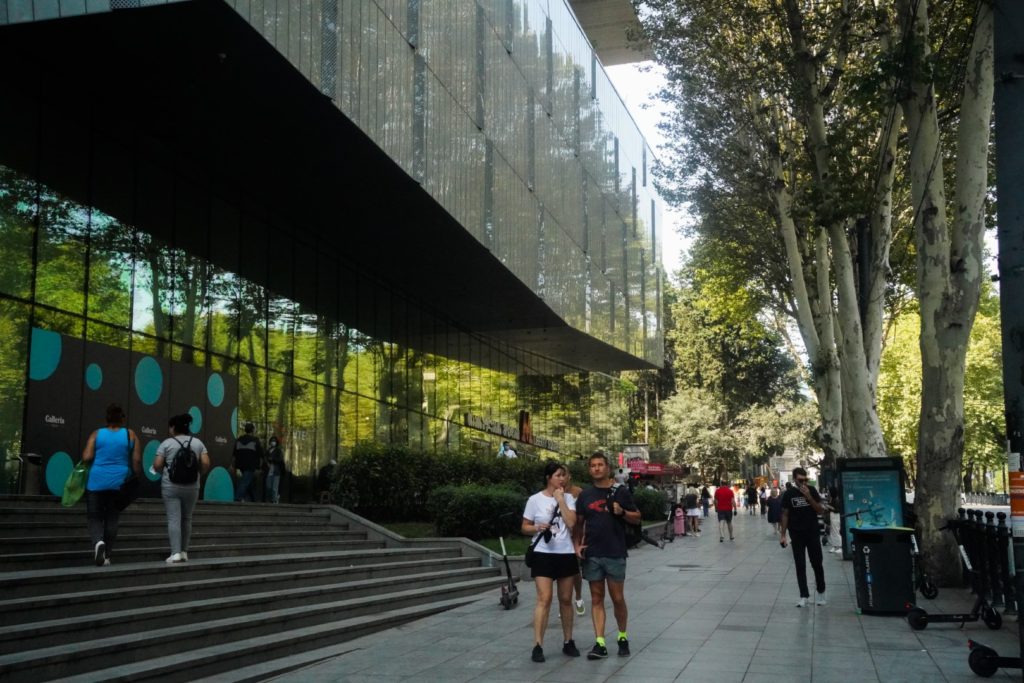



The Blue Monastery, the most beautiful church in Tbilisi
I continued to the end of the street to find a small church known as the Lurji Monastery (which translates to ‘Blue Monastery’). This Georgian Orthodox church was built in the 12th century in the name of Saint Andrew but sadly, only small parts of the original structure have survived to this day. The name of the church is derived from its glazed blue tile roof although the exquisite interior is actually much bluer than the roof.
Although the Blue Monastery is quite unknown and far from the “main sights” of Tbilisi, it was actually my favourite church in the city (and I vistied a LOT). There are also several other churches and temples in the area to explore – and lots of cute streets cats to cuddle -, so it’s well worth the little walk to get there.



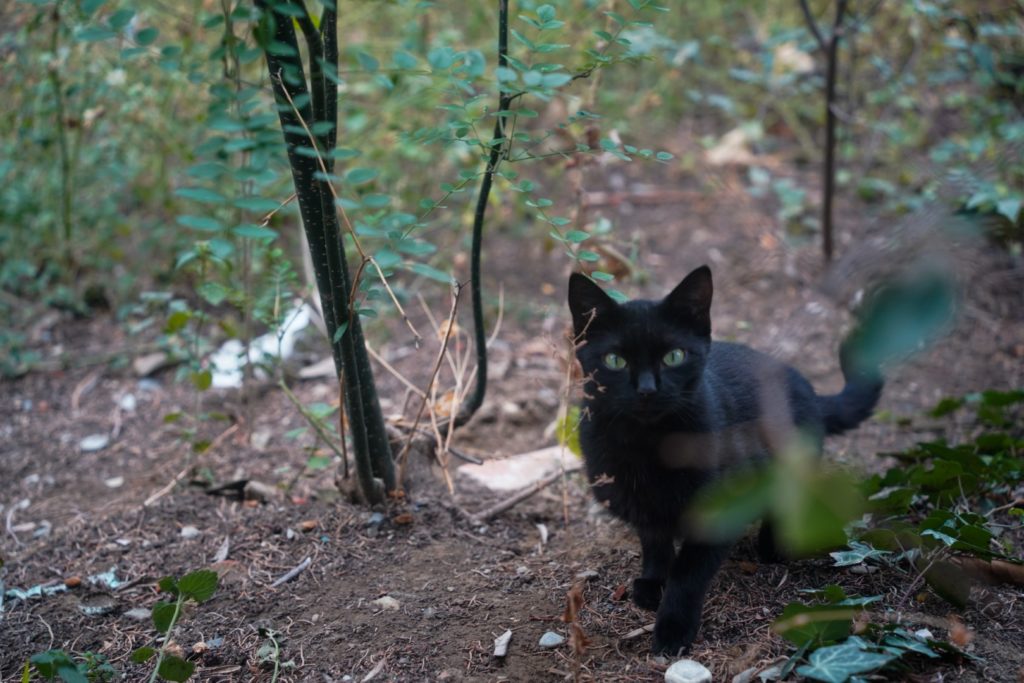
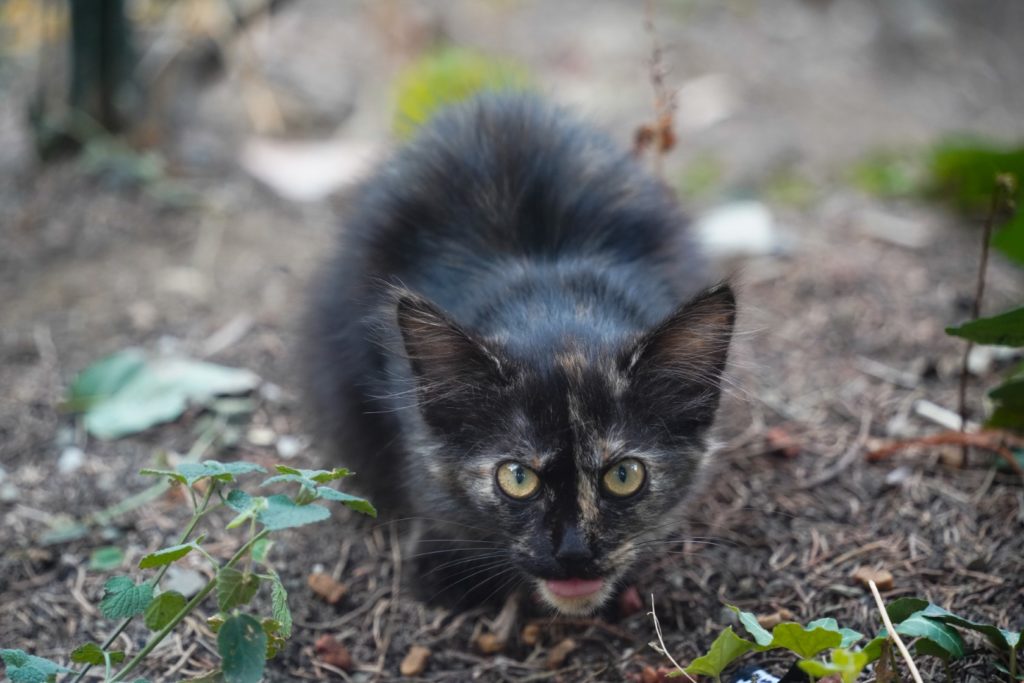
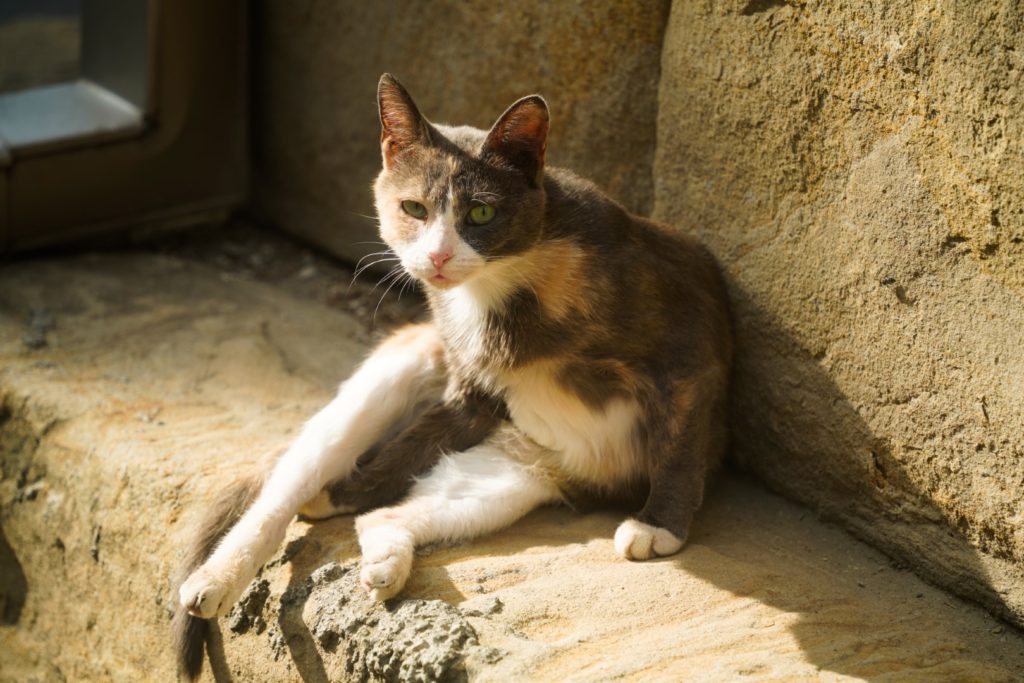

Dry Bridge Flea Market
I headed back towards the centre and down to the river Kura to explore the famous Dry Bridge Flea Market. The market sells a huge assortment of antiques and souvenirs, especially stuff from the USSR era. Flea markets like this one sprung up following the fall of the Soviet Union and exist all over Tbilisi although this one is by far the most-visited.
Having explored the market for a while, I crossed the river to enjoy the most wonderful views of the city. There’s only one thing that Tbilisi has more of than churches – and that’s amazing viewpoints!

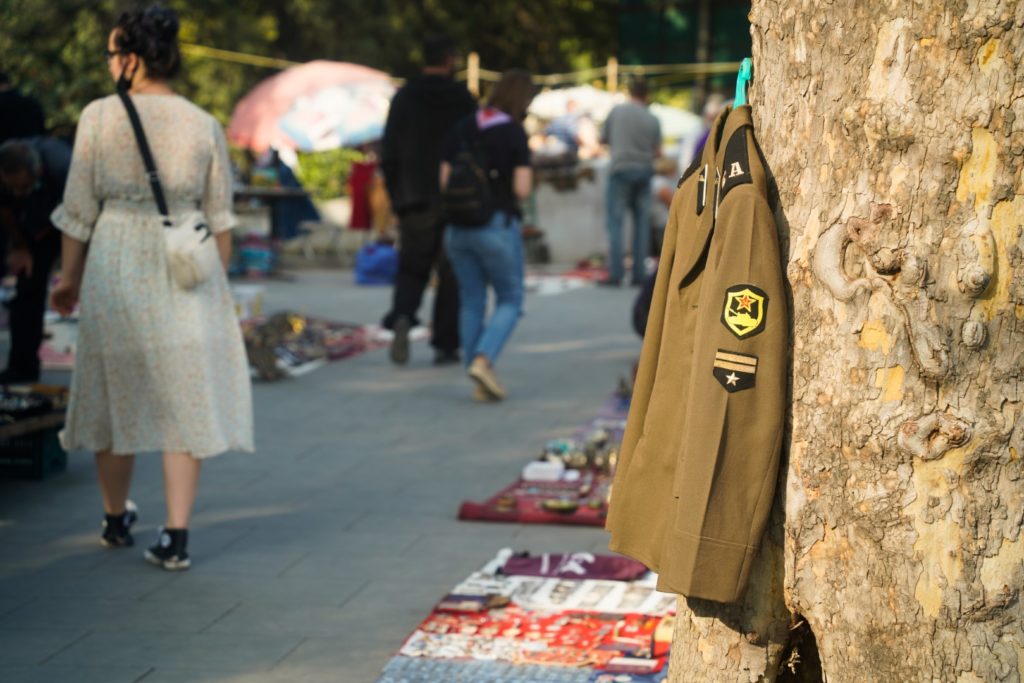
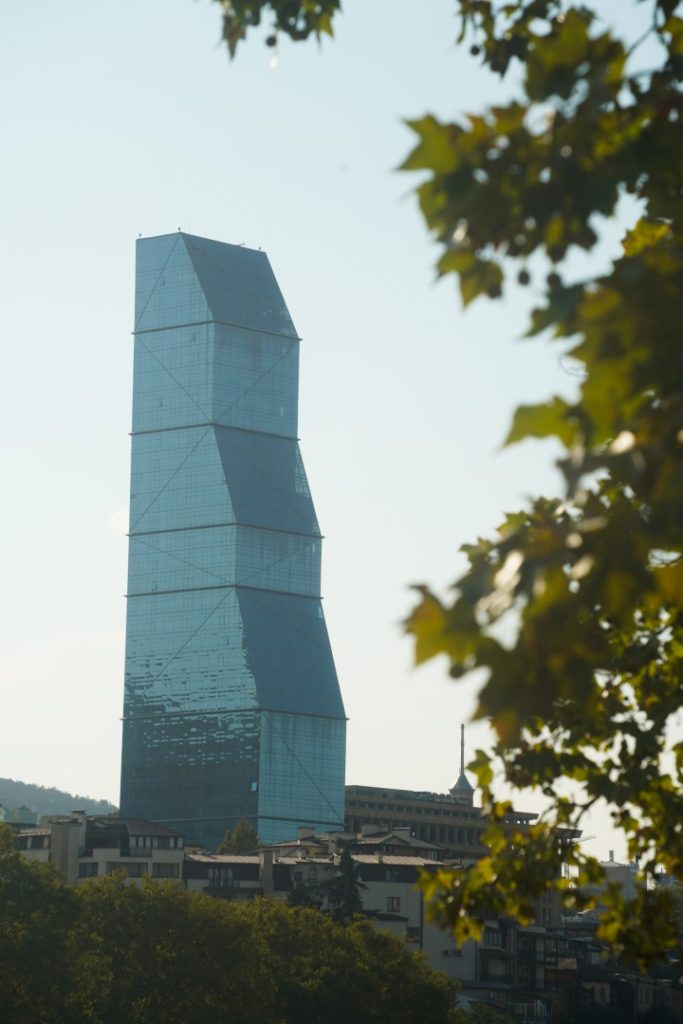


Holy Trinity Cathedral of Tbilisi, a grand landmark
Sweating in the hot September sun, I walked up steep cobbled streets past run-down neighbourhoods. The further I got from the centre, the worse the houses looked. I guess I discovered the backside of Tbilisi. Not everything is as beautiful and polished as it seems once you look beyond the centre.
Up and up I went, aiming for the Holy Trinity Cathedral of Tbilisi, a majestic building towering above these run-down neighbourhoods that I was making my way through. The gates revealed an astounding sight of one of the most impressive cathedrals I’ve ever seen, a great contrast to its surroundings.
Prayers were being offered over the loudspeakers as I wandered around the grounds of the cathedral, enjoying the views over the city and the mountains beyond. The grand cathedral was constructed between 1995 and 2004 and is the third-tallest Eastern Orthodox cathedral in the world, and one of the largest religious buildings in the world when including the total area. The cathedral was designed to incorporate different traditional styles of historic Georgian churches. It has been proclaimed as a symbol of the Georgian national and spiritual revival, being built at a crucial time in history shortly after Georgia’s independence from the Soviet Union in 1991.
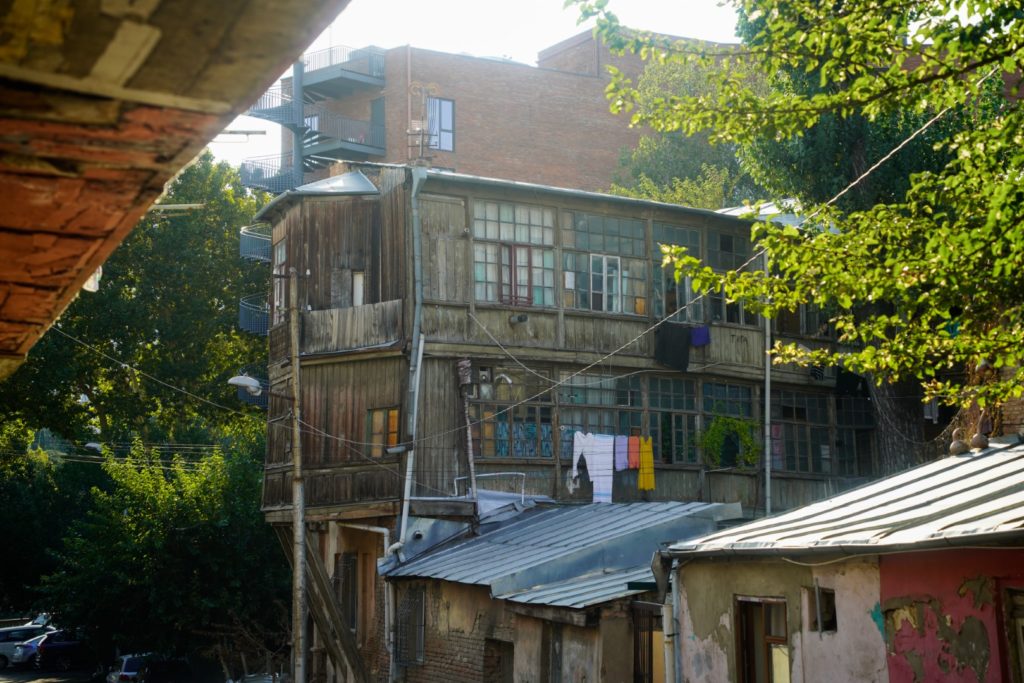


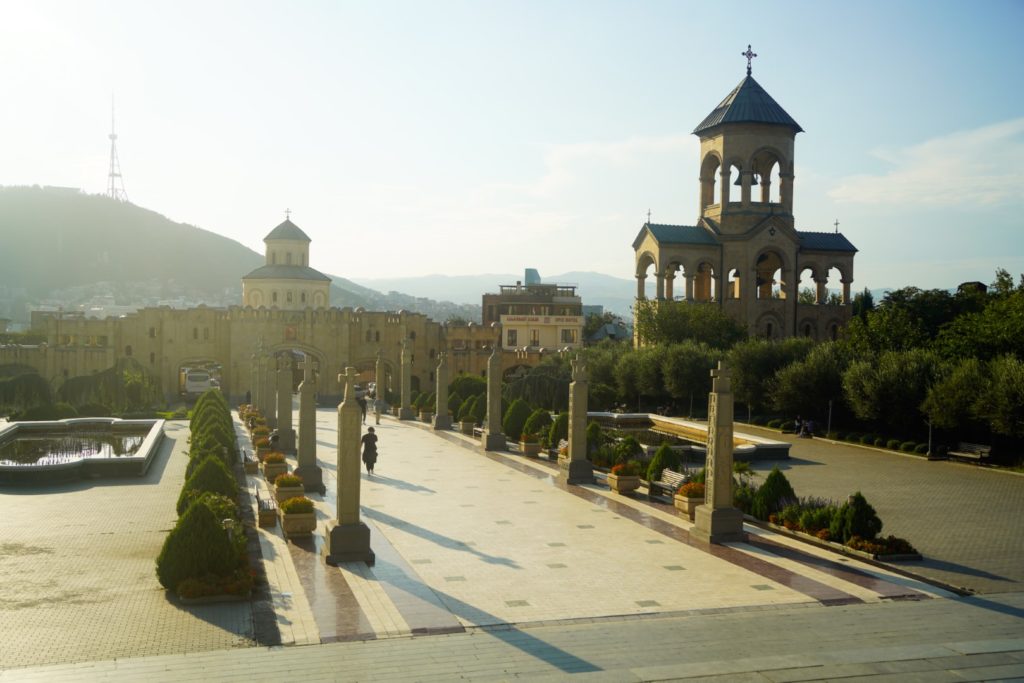

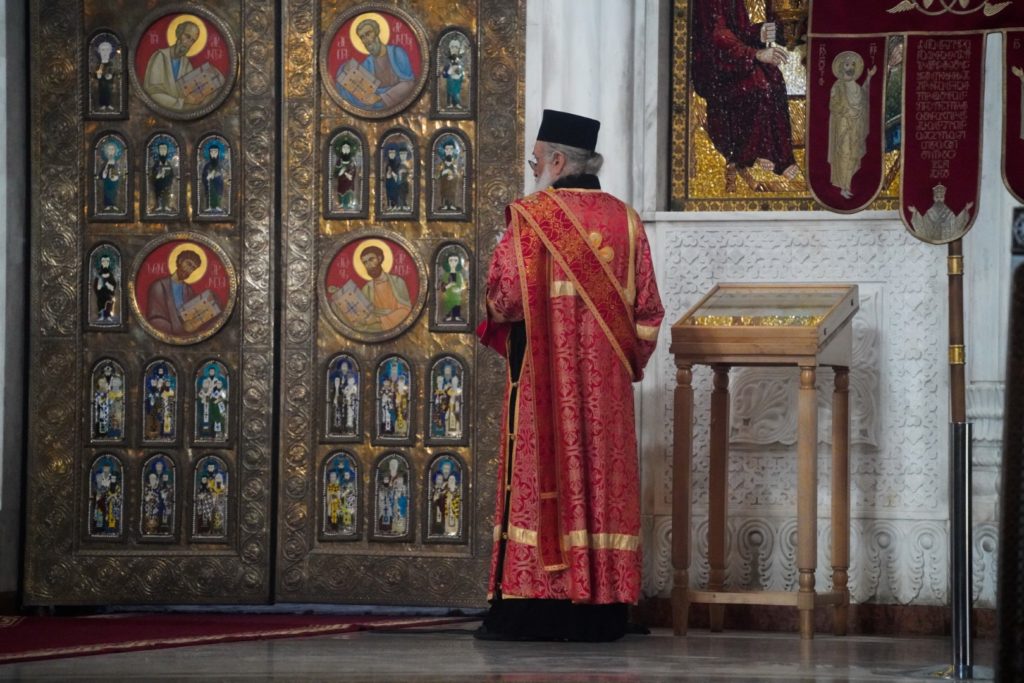
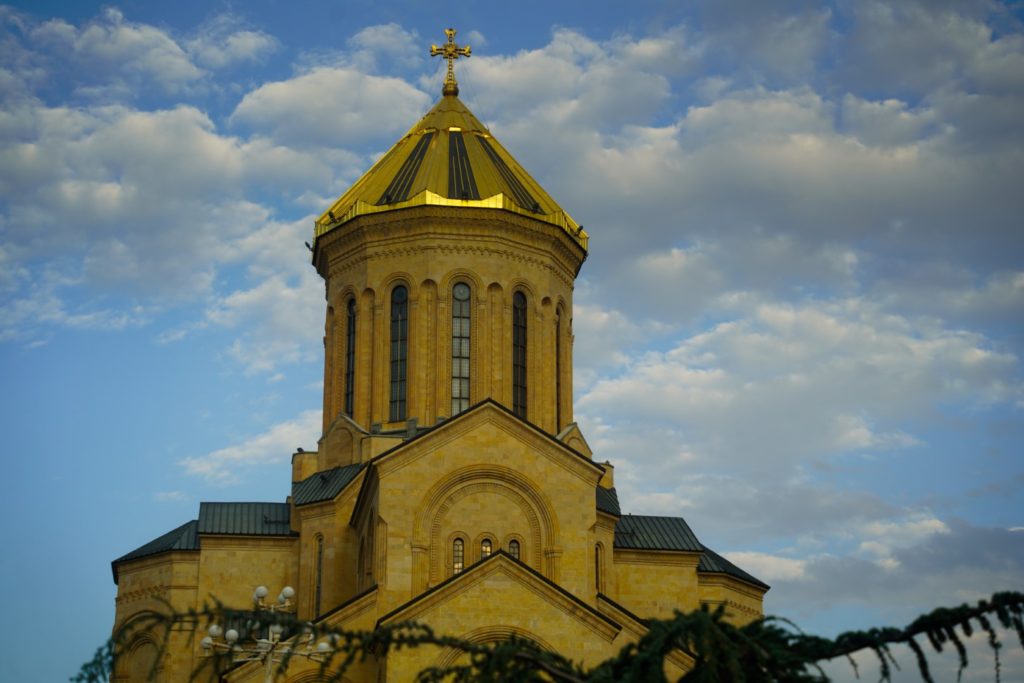
Finding the best viewpoint in Tbilisi
It was getting late and I was getting tired, so I started heading back to the hostel but of course I could not help but explore some places along the way.
I walked down towards the river again to a different bridge and came across a wonderful view of the Rike Park in the heart of the city. I stumbled upon a surprising sight, part of the Berlin Wall which was gifted to Georgia from Germany in an act of friendship.
Before crossing the bridge, I walked up a small hill and paid a visit to Metekhi Church which dates back to the late 13th century and is very well preserved with much of the original structure remaining. Outside the church stands the statue of King Vakhtang I of Iberia, the founder of Tbilisi in the 5th century, with my favourite view of the colourful buildings of the old town. Tbilisi is like a mosaic of beautiful buildings and nowhere gives as perfect of an example of this than the view seen from this hill.


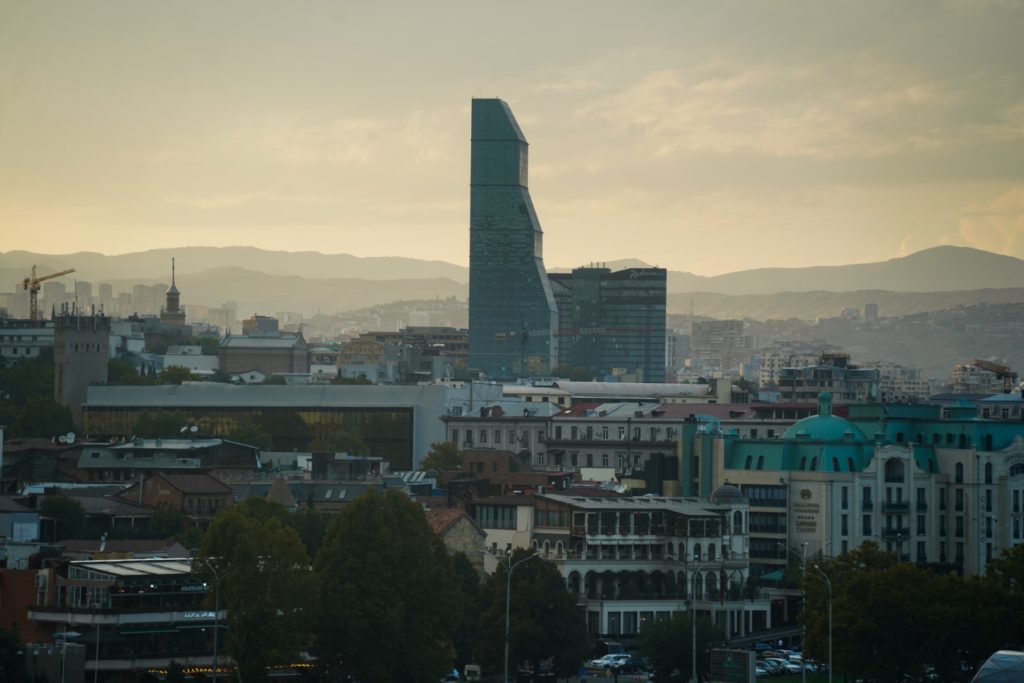


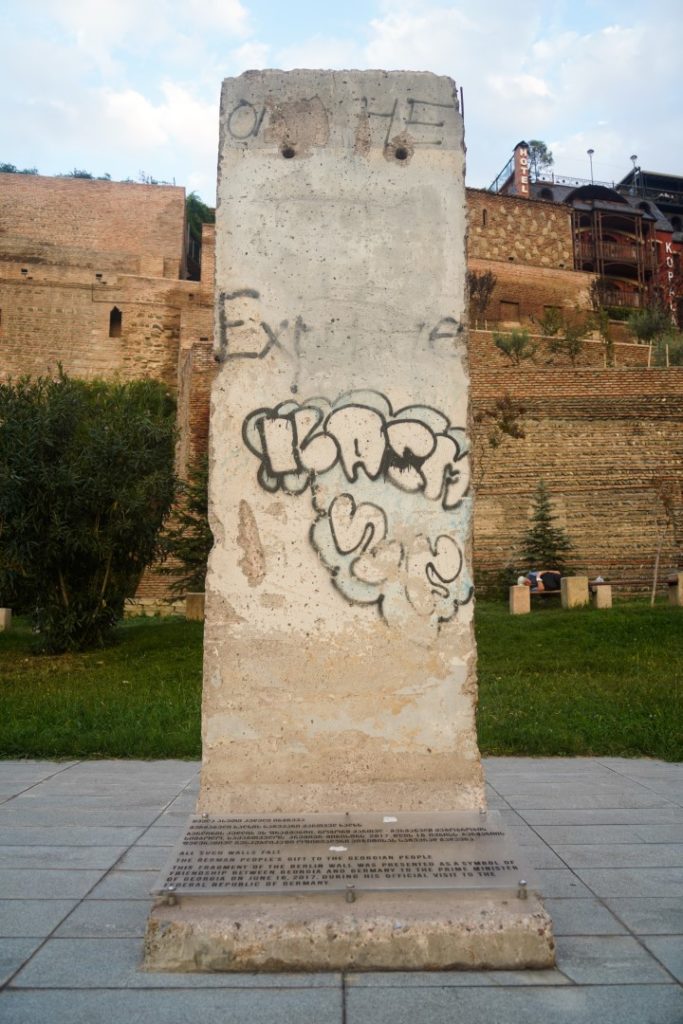
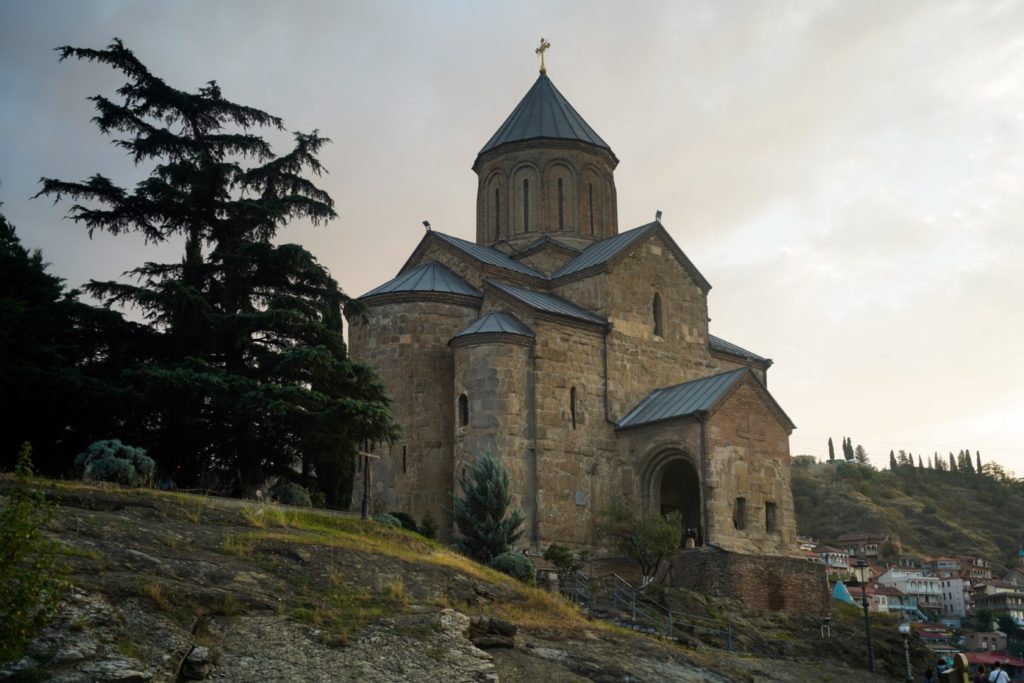
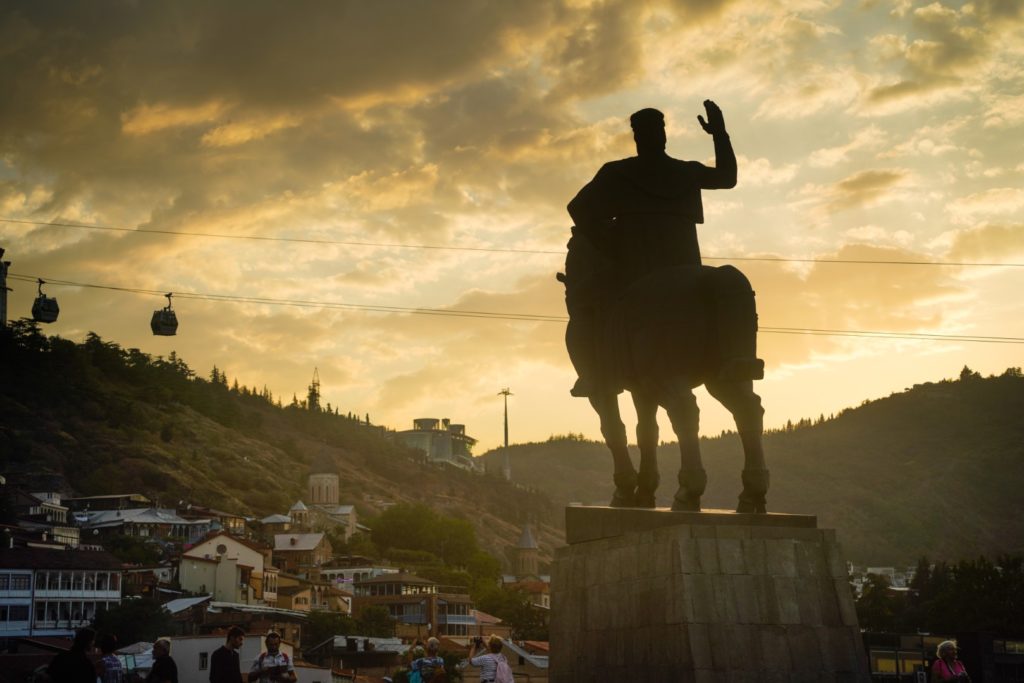
I crossed over the bridge, taking in more gorgeous views, and landed back in the old town where my hostel is located.
Although exhausted from the long day, I spent the evening out with Yente and some friends of his, and then went back to the hostel and got caught up in talk on the rooftop that lasted till past 2 AM. After almost two years of no backpacking due to the pandemic, I’d forgotten just how fun hostel life can be!

Above Tbilisi at Narikala Fortress
The following day, I woke up late and decided to spend the day by myself to allow my inner introvert to recover from all the encounters I’d had the previous day.
I started my day by walking up the steep streets to the fortress that overlooks the city.
Narikala is an ancient fortress consisting of two walled sections above the old town and in front of the botanical gardens of Tbilisi. On the lower court stands St Nicholas Church, built in 1996-97 in replacement of a 13th-century church that was destroyed in a fire. The earliest written accounts of the fortress are from the second half of the 4th century AD, however, most of the existing structure dates back to the 16th and 17th centuries.
The fortress in itself isn’t the most impressive of its kind, but the location sure is. I had a great time climbing the fortress walls to find fresh perspectives of Tbilisi from above.
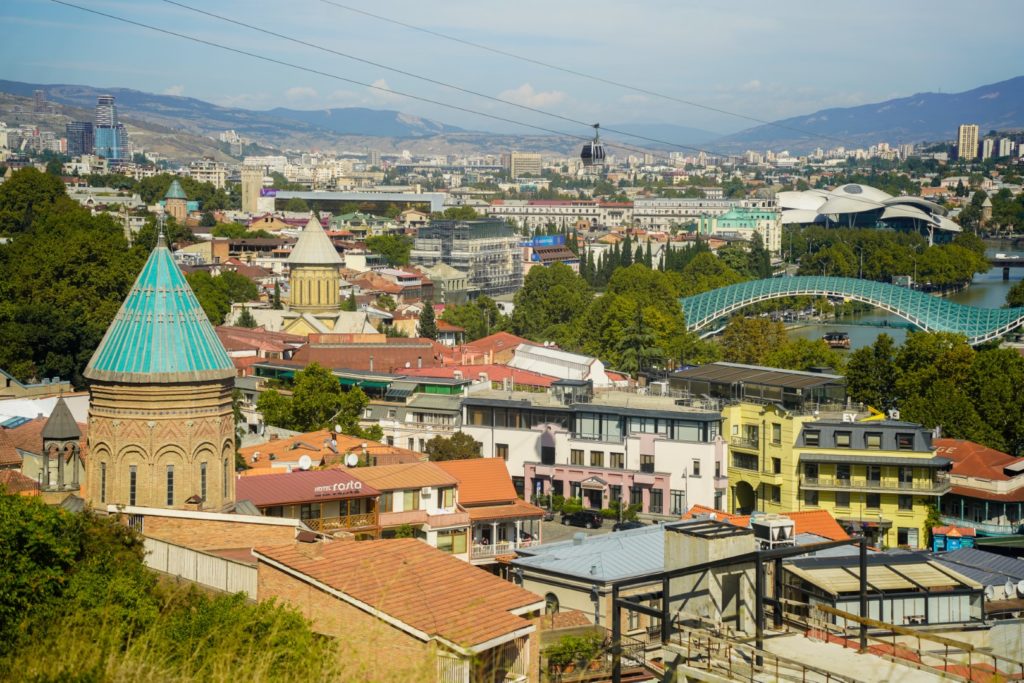
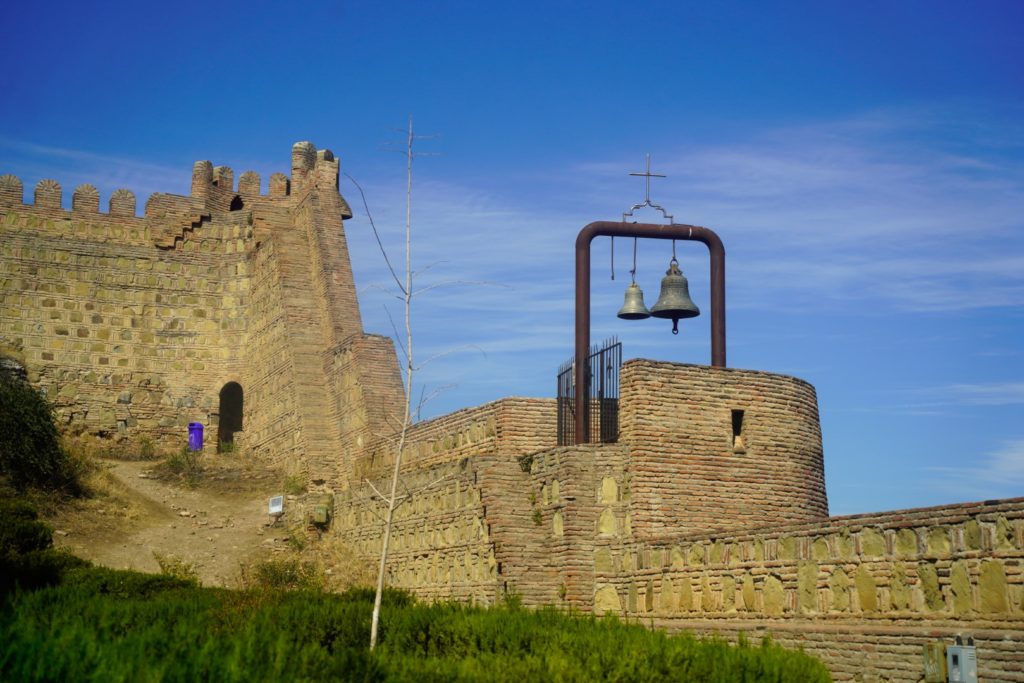



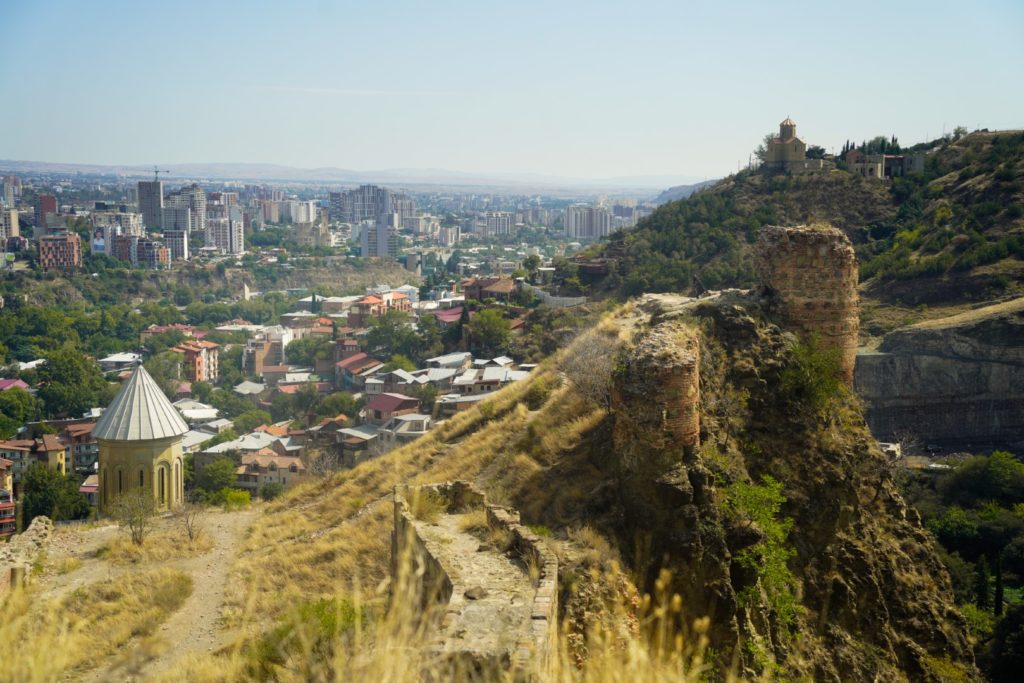
A unique mosque of peace
I headed back down from the fortress a different way than I’d come up, giving me lovely views over the Jumah Mosque from the 18th century where the Sunni and Shia Muslims of Tbilisi pray side by side.
Traditionally, Sunni and Shia Muslims worship separately, but following the demolition of the Blue Mosque in 1951 to make way for a bridge, the Shia community no longer had a place to go for prayer, which prompted the Sunni community to welcome them to their mosque, Jumah, which they have shared ever since. This is a truly unique act of friendship and peace, and it’s in fact one of the only mosques in the world where worshippers of these two branches of Islam pray together!

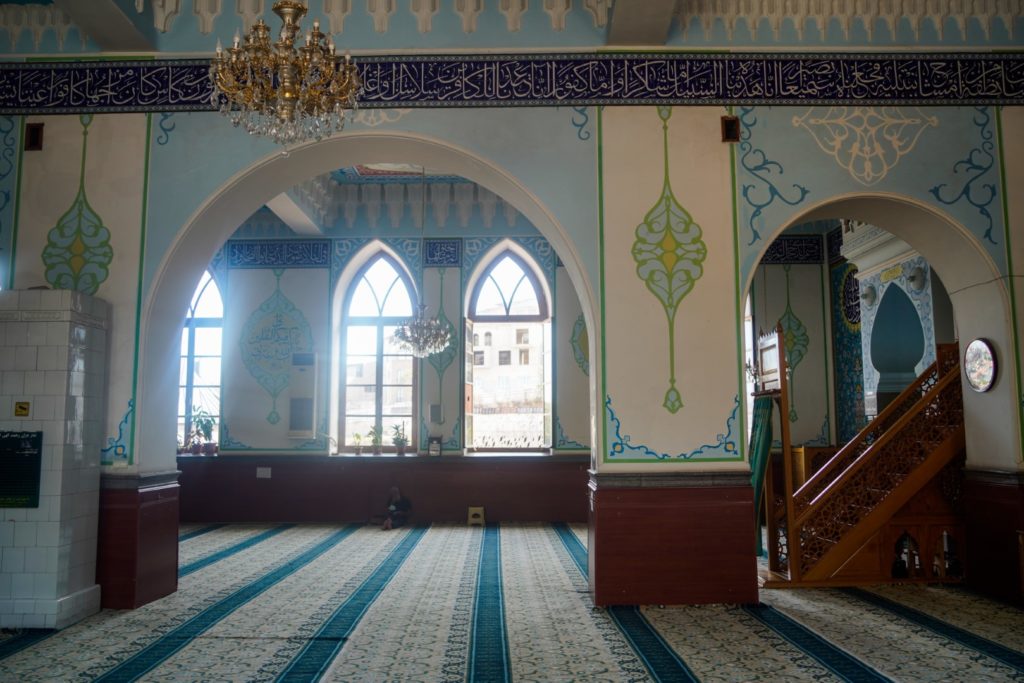
Leghvtakhevi Canyon and the sulfur baths of the Abanotubani district
The mosque is located amid the famous sulfur baths of the ancient Abanotubani district. I decided to skip this experience as getting naked with a bunch of strangers is my least favourite activity, so instead I just admired the beautiful exteriors of the bath houses while chatting to a large group of Danes that I randomly ran into.
Directly behind the sulfur baths lies one of Tbilisi’s best kept secrets, a canyon in the middle of the city!
Street musicians were playing and street vendors offered fruits and juices. I bought some strawberries and walked deep into the canyon to the Tsavkisi waterfall that cascades down the cliff wall at the far end of the canyon.
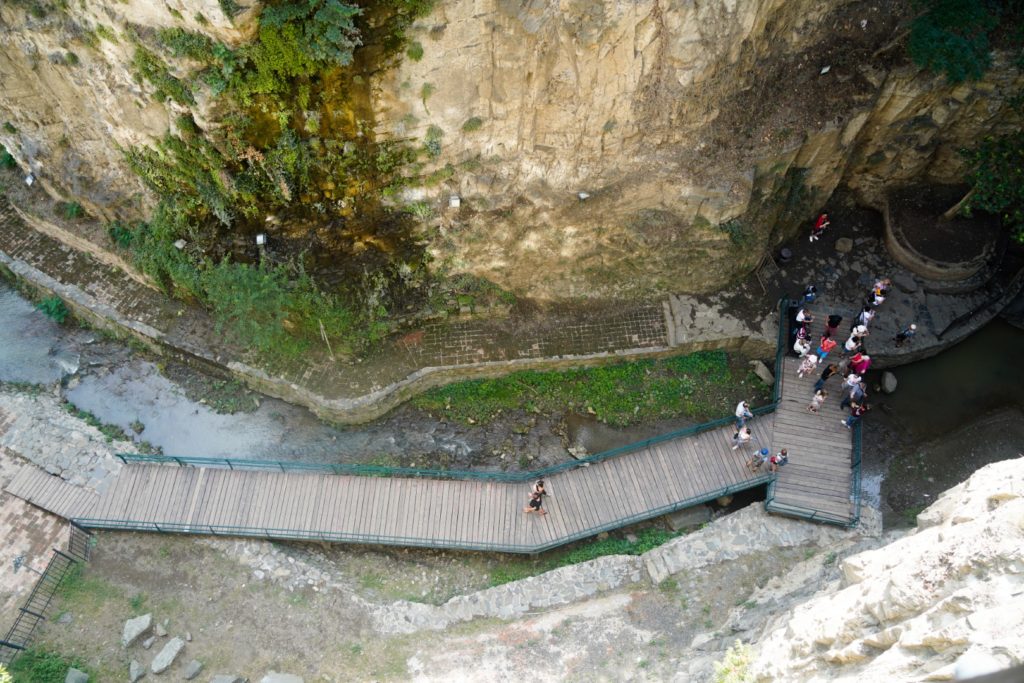
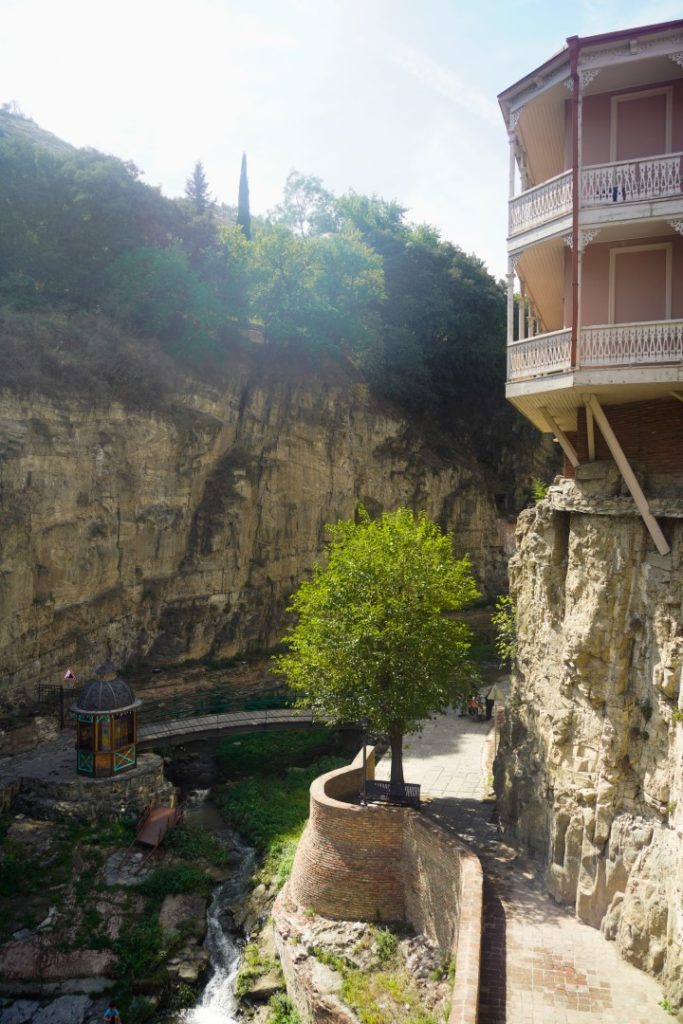
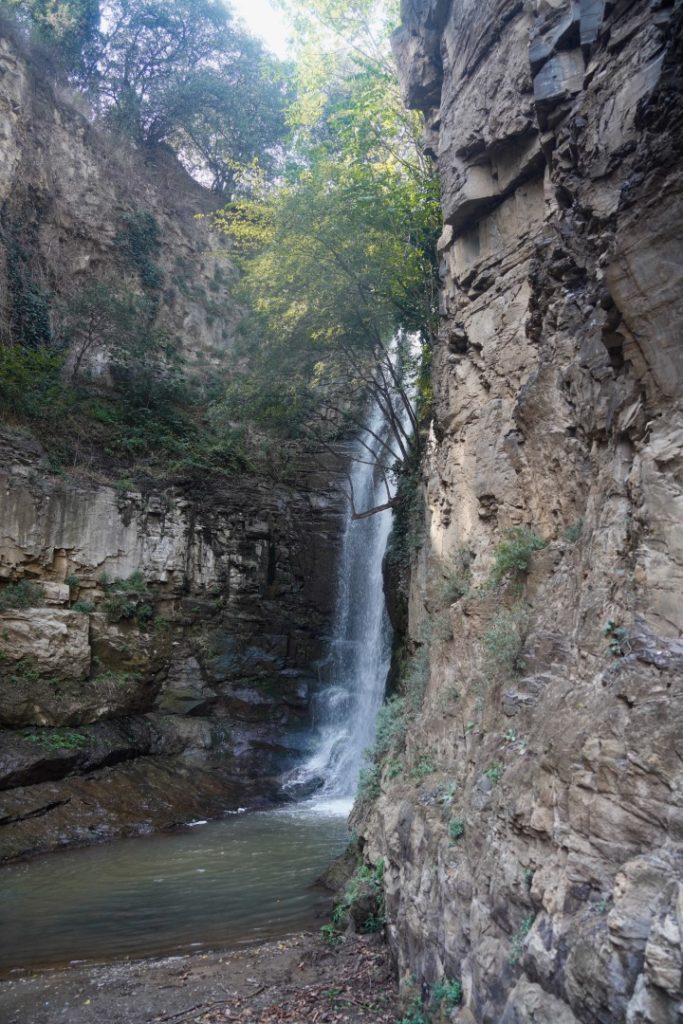


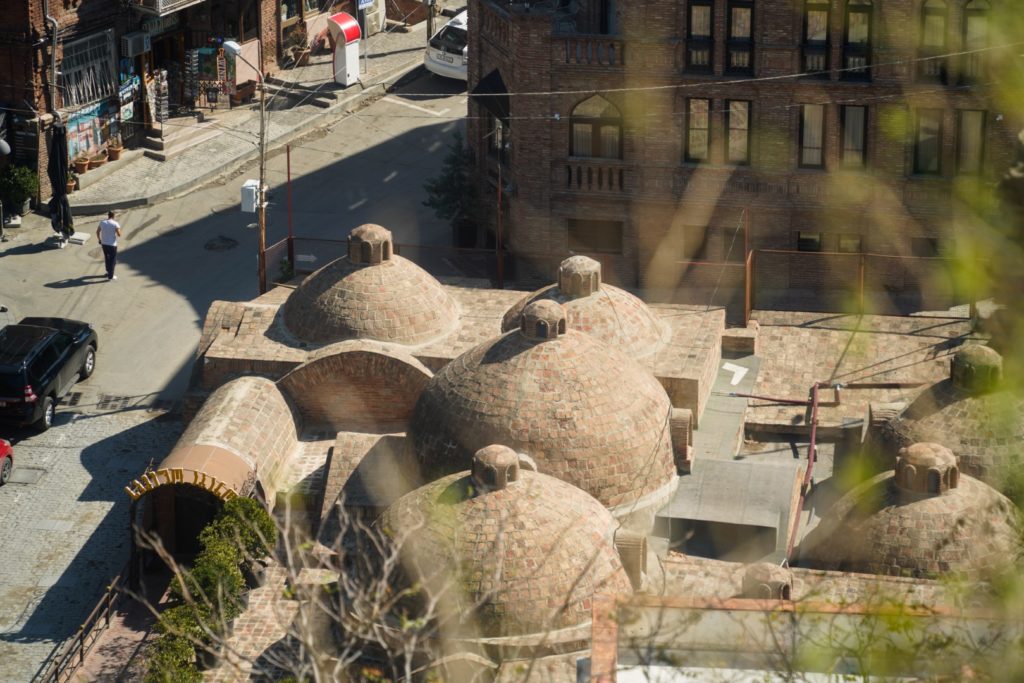
The oldest church in Tbilisi and a quirky leaning tower
Suddenly feeling hungry, I looked up vegan food nearby and stumbled upon Kafe Leila which is a vegetarian café with many vegan options. And what a gem of a café that was! Elaborately decorated and with really good food.
The café is located in a cozy street right next to the Anchiskhati Basilica of St Mary, the oldest surviving church in the city. It dates back to the 6th century AD and is said to have been built by King Dachi of Iberia (ca. 522-534 AD) who made Tbilisi his capital. Unfortunately, the basilica was damaged and rebuilt several times from the 15th through 17th centuries during the wars between Georgia and the Persians and Ottomans.
Next to the church is another one of Tbilisi’s quirks, the Rezo Gabriedze Theatre with an old crooked clock tower known as the Leaning Tower of Tbilisi. Every hour, an angle appears from behind the small wooden doors to strike the bell!


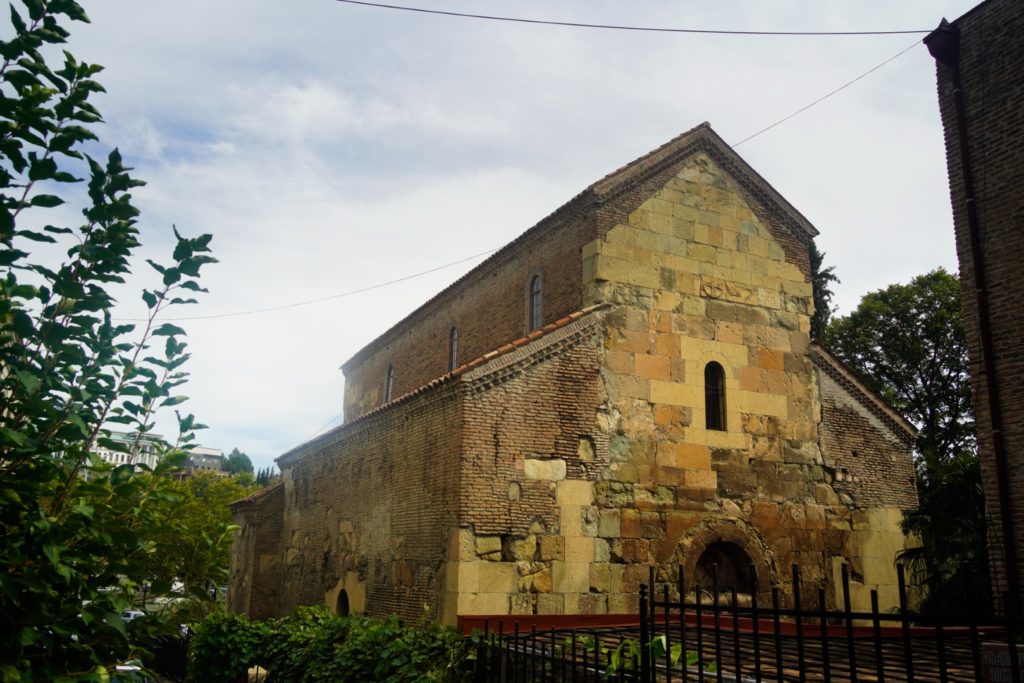
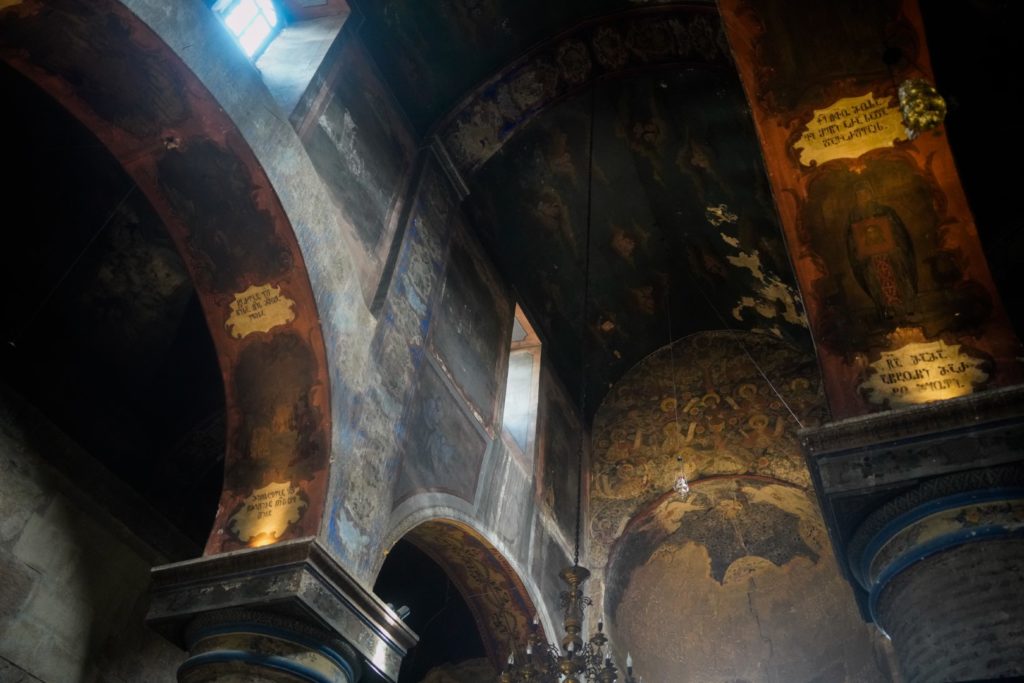

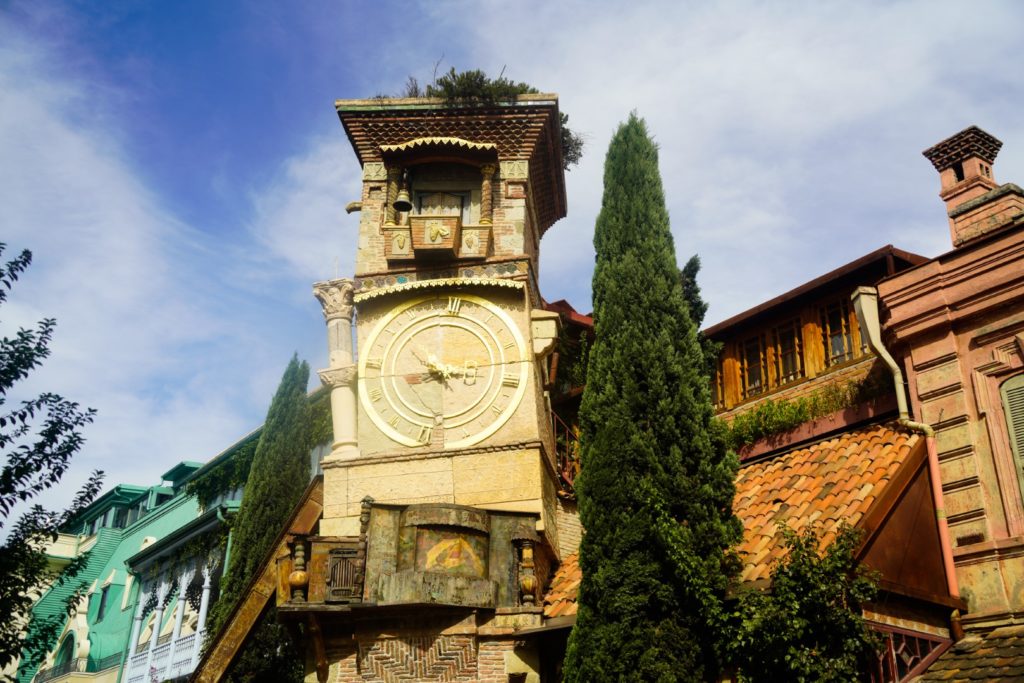
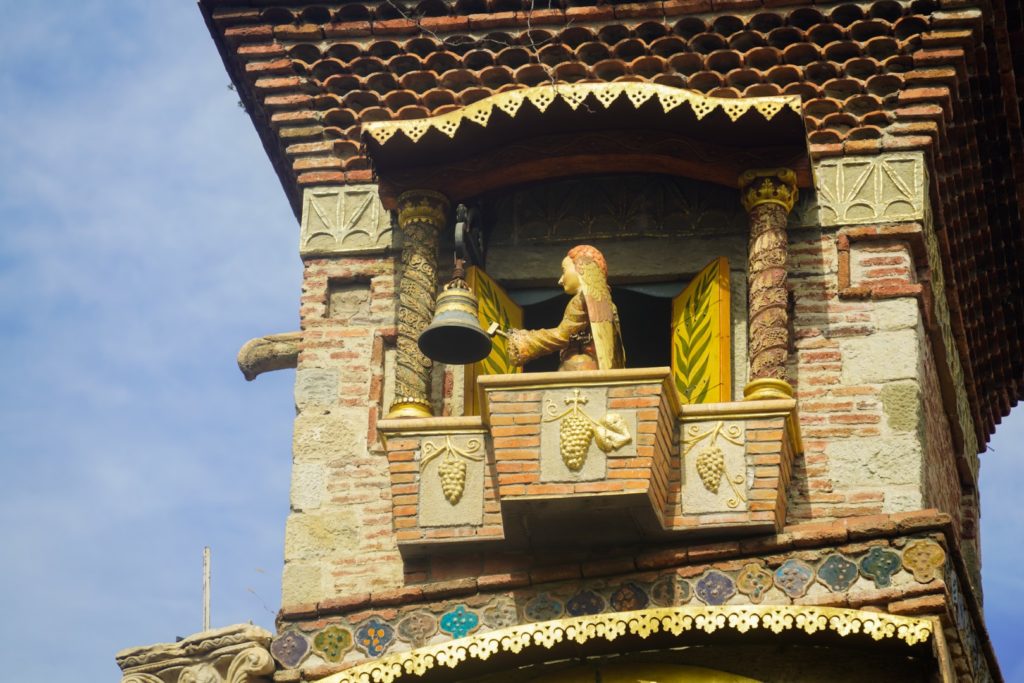
The Bridge of Peace (… and controversy!)
I headed down to the river Mtkvari and the Bridge of Peace, an odd bit of modern architecture among the old buildings of the historical districts of Tbilisi. Often described as an architectural masterpiece, this interesting bridge has a bit of controversy behind its existence. Some locals complained that the bridge would dominate the historic landmarks, and I can certainly understand their concerns. Nevertheless, it has become almost mandatory to walk over the bow-shaped bridge for anyone visiting the city.
I did so too, and then continued along the river until I reached Sioni Cathedral, dating to the 6th-7th centuries but since destroyed and reconstructed several times. The church currently standing was built in the 13th century with some changes made in the 17th-19th centuries. Sioni Cathedral was the main Georgian Orthodox Cathedral until the Holy Trinity Cathedral (mentioned above) was consecrated in 2004.


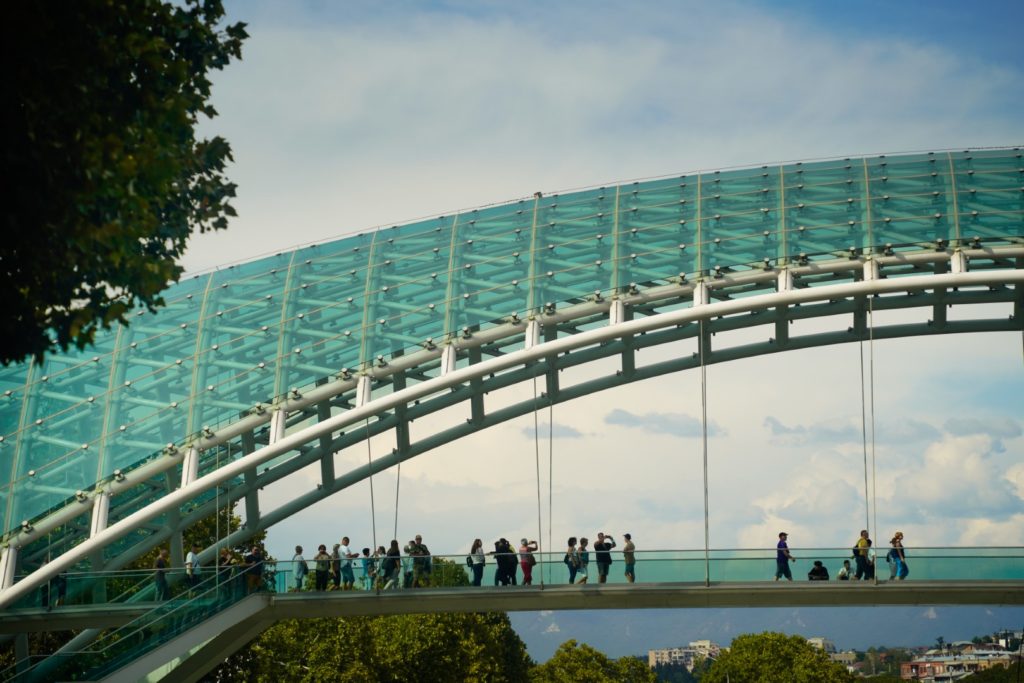



Upper Bethlehem Church and the Kartlis Deda statue
I grabbed a vegan cheese cake to-go at a vegan café I just happened to stumble upon, and headed towards the last church of the day, the Holy Mother of God Church of Bethlehem, also known as the Upper Bethlehem Church, built in the 18th century on the site of an older Armenian church at the foot of Narikala Fortress. I entered the dimly lit building as a man was reciting prayers and stood in silence enjoying the elaborately detailed interior.
I climbed the staircase behind the church leading up to Kartlis Deda, the Mother of Georgia statue, a 20-metre aluminium figure of a woman in Georgian national dress, erected on top of Sololaki hill in 1958 for the celebration of Tbilisi’s 1500th anniversary.
Kartlis Deda symbolizes the Georgian national character. In her left hand, she holds a bowl of wine to greet those that come as friends, and in her right hand, she carries a sword for those that come as enemies.



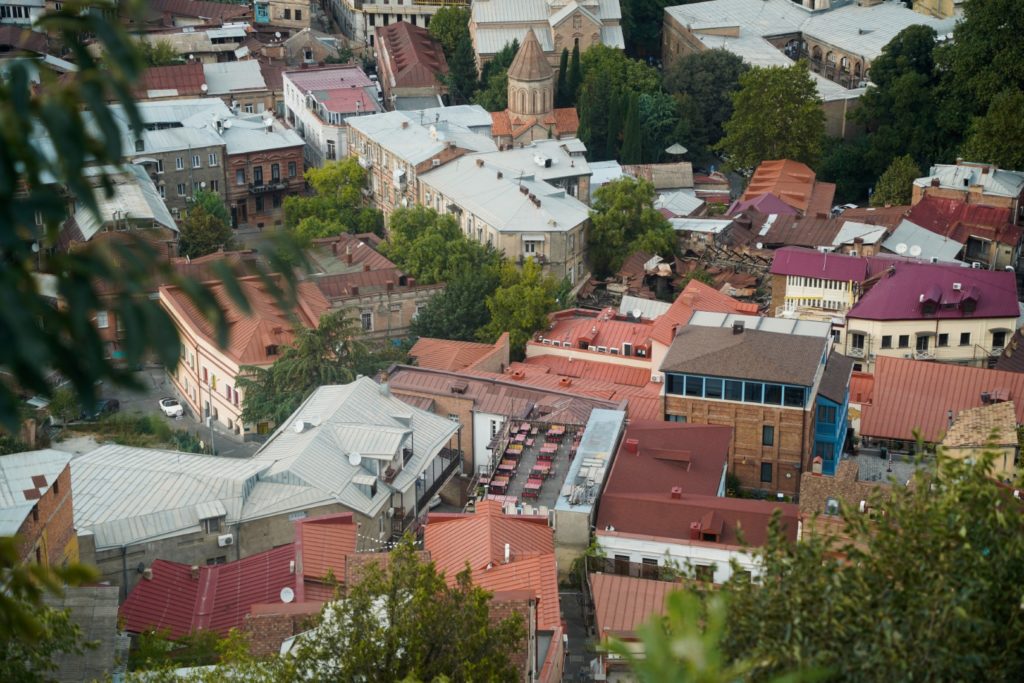
Sunset in the Botanical Gardens
I headed down the other side of the hill and entered the Botanical Gardens for just 4 lari. That was the first time I’d had to pay entrance for anything in Tbilisi, and it was very cheap for what it was. I spent the rest of my evening before sunset exploring the gardens, relaxing on a bench and enjoying my vegan cheese cake in the most peaceful surroundings among over 4,500 plant species.
As I wandered back towards the hostel, I saw the most gorgeous sunset with pink hues over the backside of the fortress.
The rest of the evening was spent chilling on the hostel terrace with four new friends whom I joined for an overnight adventure to Kazbegi the following day!

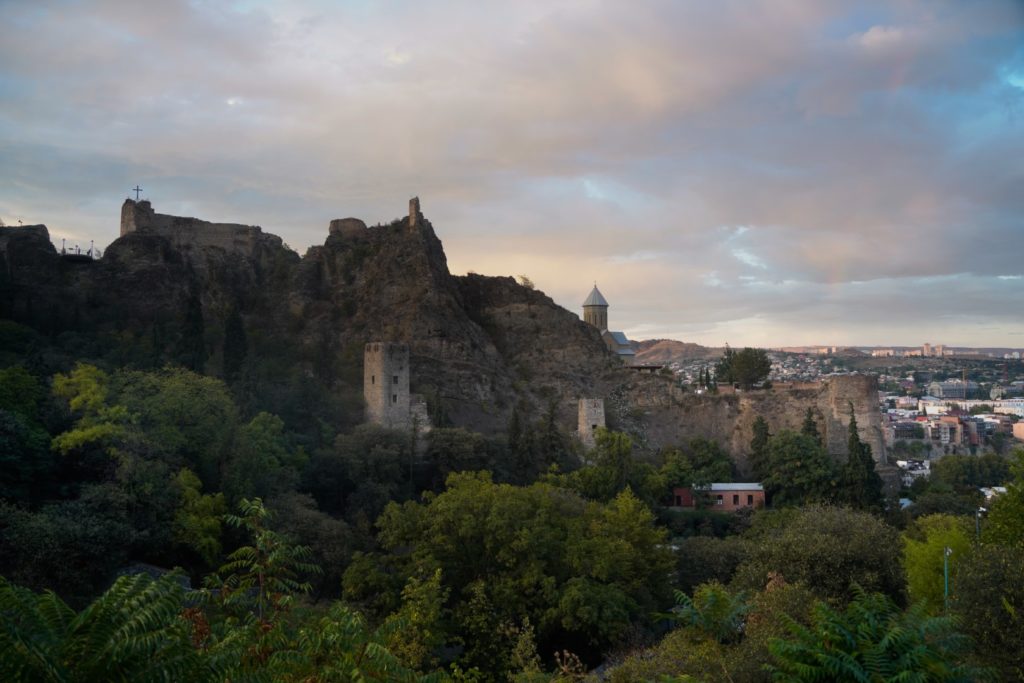

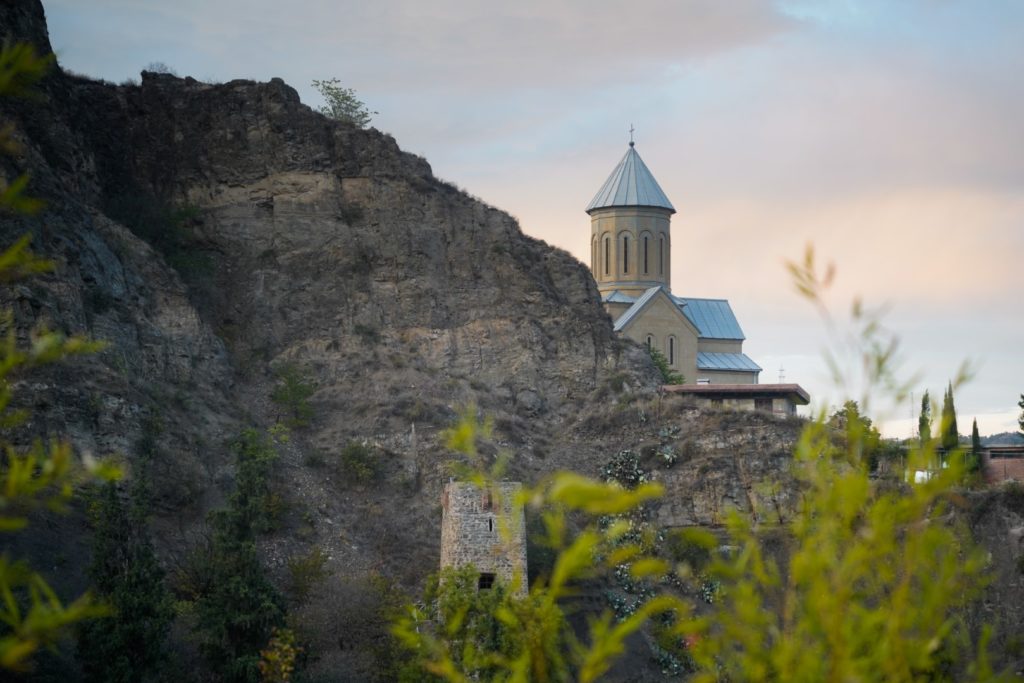

After our trip to Kazbegi, I returned to Tbilisi for another two nights. Of course, I chose to stay at Envoy Hostel again as that place gave me everything I’d missed about hostel life.
I spent those two days wandering the streets of Tbilisi with two new friends from the hostel. We ate delicious Georgian food at several of A’s favourite cafés and restaurants, and I discovered the abundance of delicious vegan options the Georgian kitchen offers (I’m especially fond of mushroom khinkhali and phkali/mhkali). We learned about Georgia’s prehistory and near history with the Soviet occupation at the National Museum. We discovered the exposed ruins of old buildings where the remnants of the walls have been incorporated into new building projects. We found lots of cool street art and went shopping in thrift stores. We cuddled street dogs and cats in abundance. We experienced the rainfall of a century that appeared in a second and ended just as quickly. And the night before leaving Tbilisi again, one of the guys and I took the funicular up to the fortress to see the city by night from above.
After a whirlwind of a trip to Kutaisi, Mtskheta and the mountainous region of Svaneti, I returned to Tbilisi for a last night as I was leaving the following morning. Along with a travel buddy, I enjoyed a lovely meal at a cozy café in the city centre, and then went to Envoy Hostel for a last night of terrace fun with the other guests.
My time in Tbilisi and Georgia as a whole had come to an end, but my writings about the country and all the adventures it offered certainly has not. Do stay tuned for much much more as I take you with me to Kazbegi, Kutaisi, Svaneti and Mtskheta!
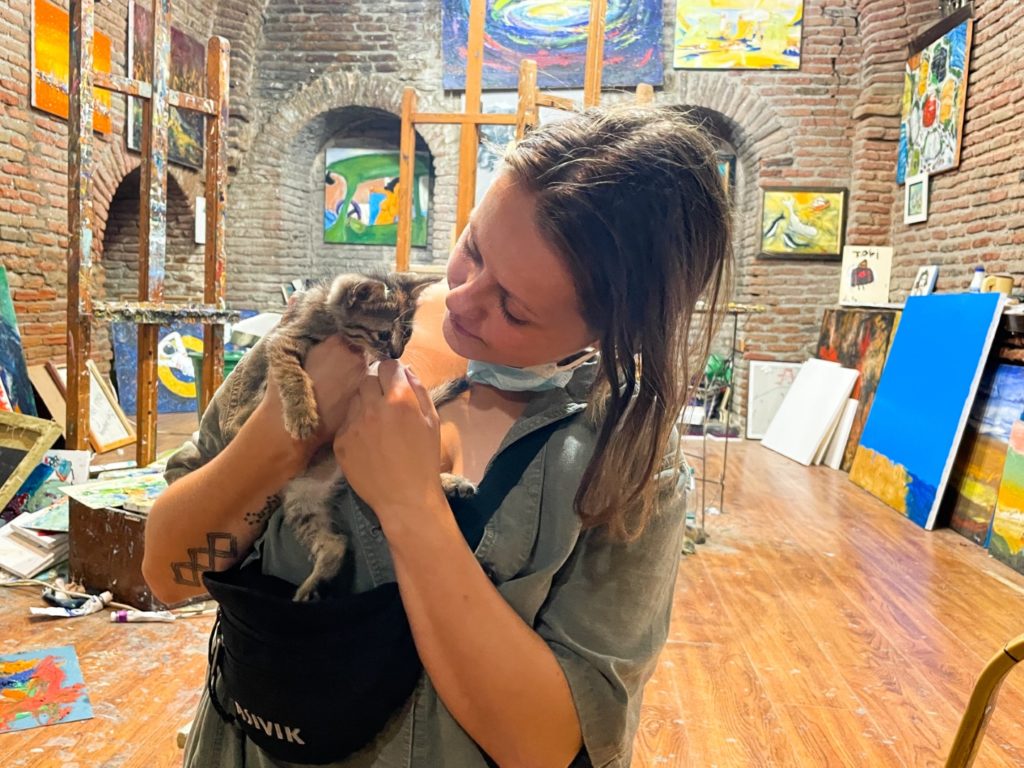




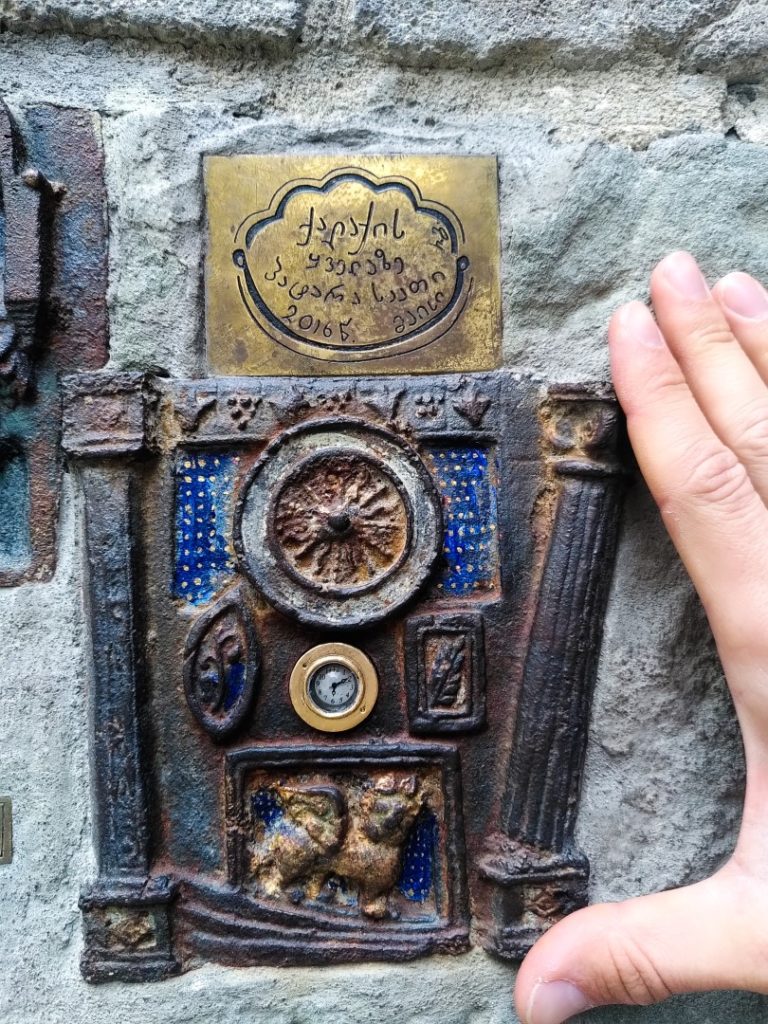
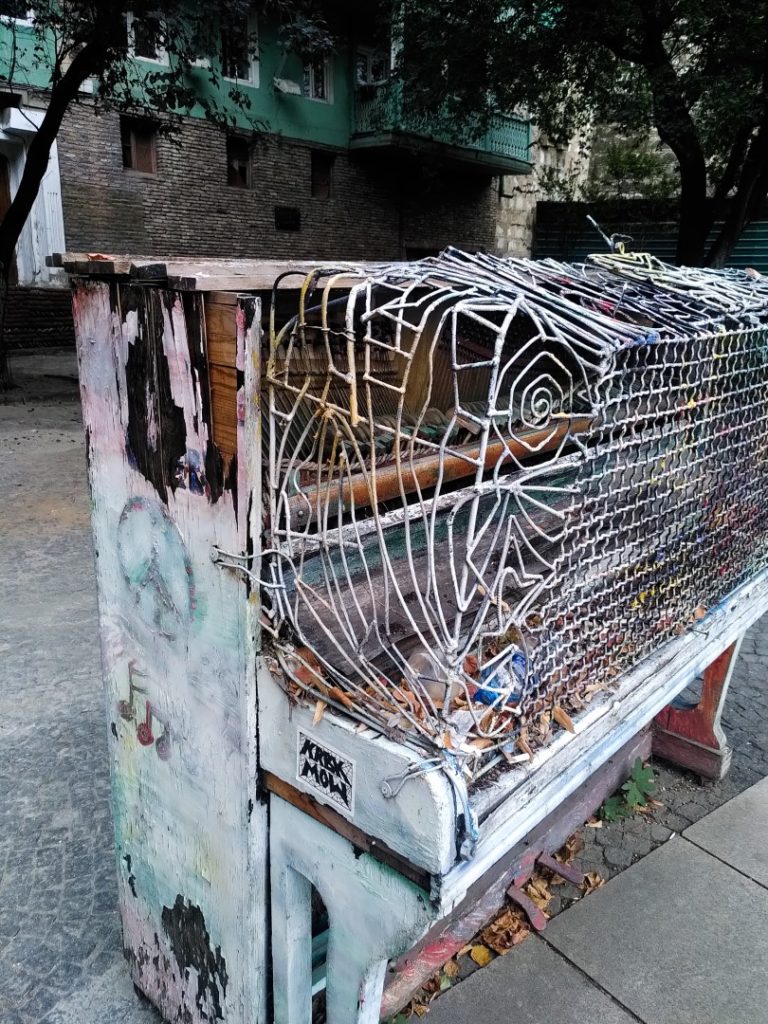
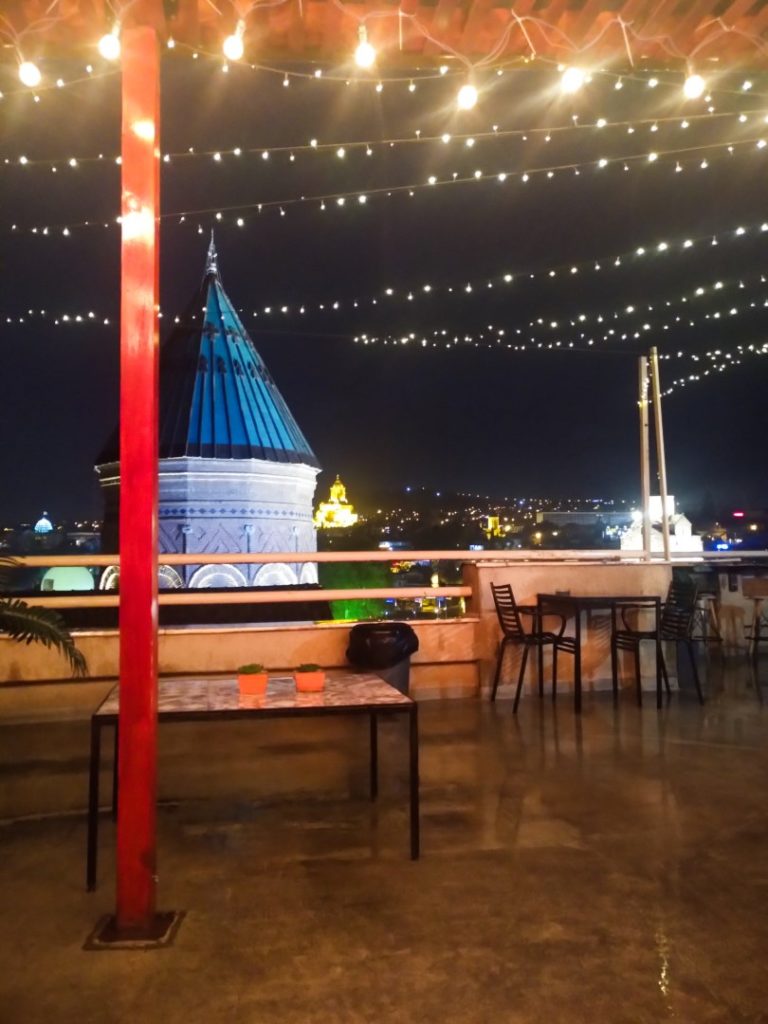


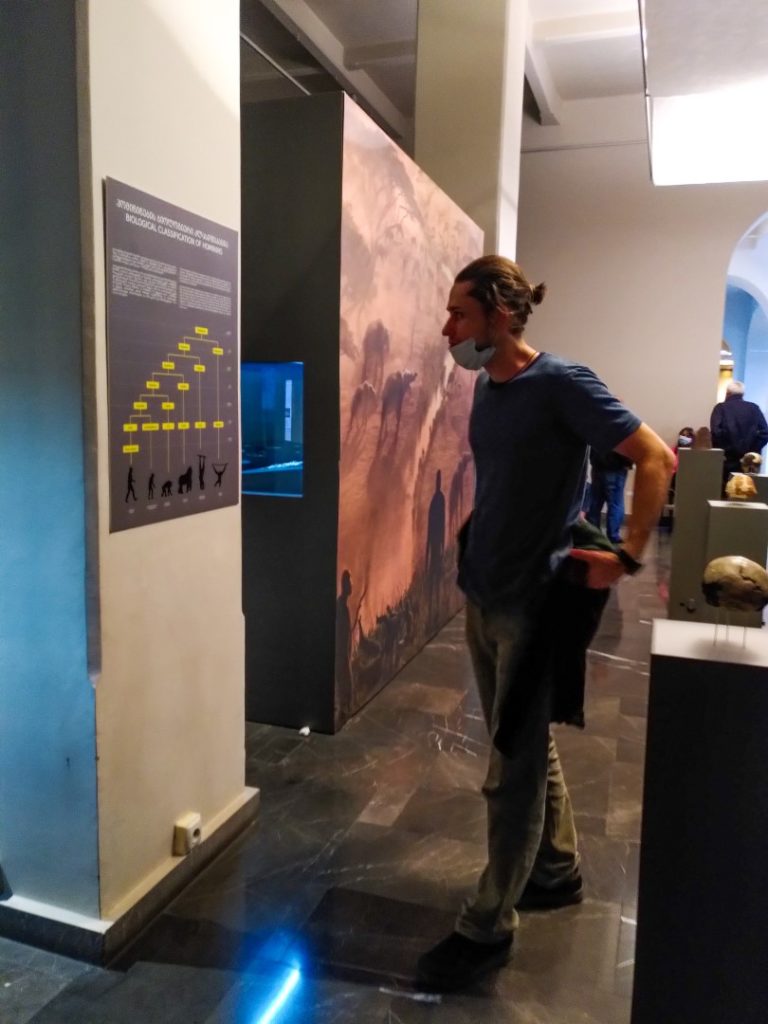
My top 10 experiences in Tbilisi
- Blue Monastery
- Holy Trinity Cathedral of Tbilisi
- Sunset at the Botanical Gardens
- View from the statue of King Vakhtang I of Iberia
- View from Narikala Fortress (especially at night)
- Leghvtakhevi Canyon and nearby sulfur baths
- Anchiskhati Basilica of St Mary
- Terrace views at Envoy Hostel
- Getting lost in the streets
- View from the Kartlis Deda statue
WANT MORE INFO?: Download a city guide for Tbilisi with GPSmyCity here!
Leave a Comment
Pingback: My travel year of 2021 – I Live as I Dream on 16/12/2021
Pingback: Borđoš 2021: A diary from two weeks of geophysical surveys in Serbia – I Live as I Dream on 16/12/2021
Pingback: Kazbegi National Park, Georgia: A hike above the Gergeti Trinity Church – I Live as I Dream on 16/12/2021
Pingback: Ancient monasteries & other adventures: Our spontaneous trip to Georgia’s Kutaisi – Northtrotter on 16/12/2021
Pingback: Mtskheta, Georgia: Exploring the country’s ancient capital at dusk – Northtrotter on 16/12/2021
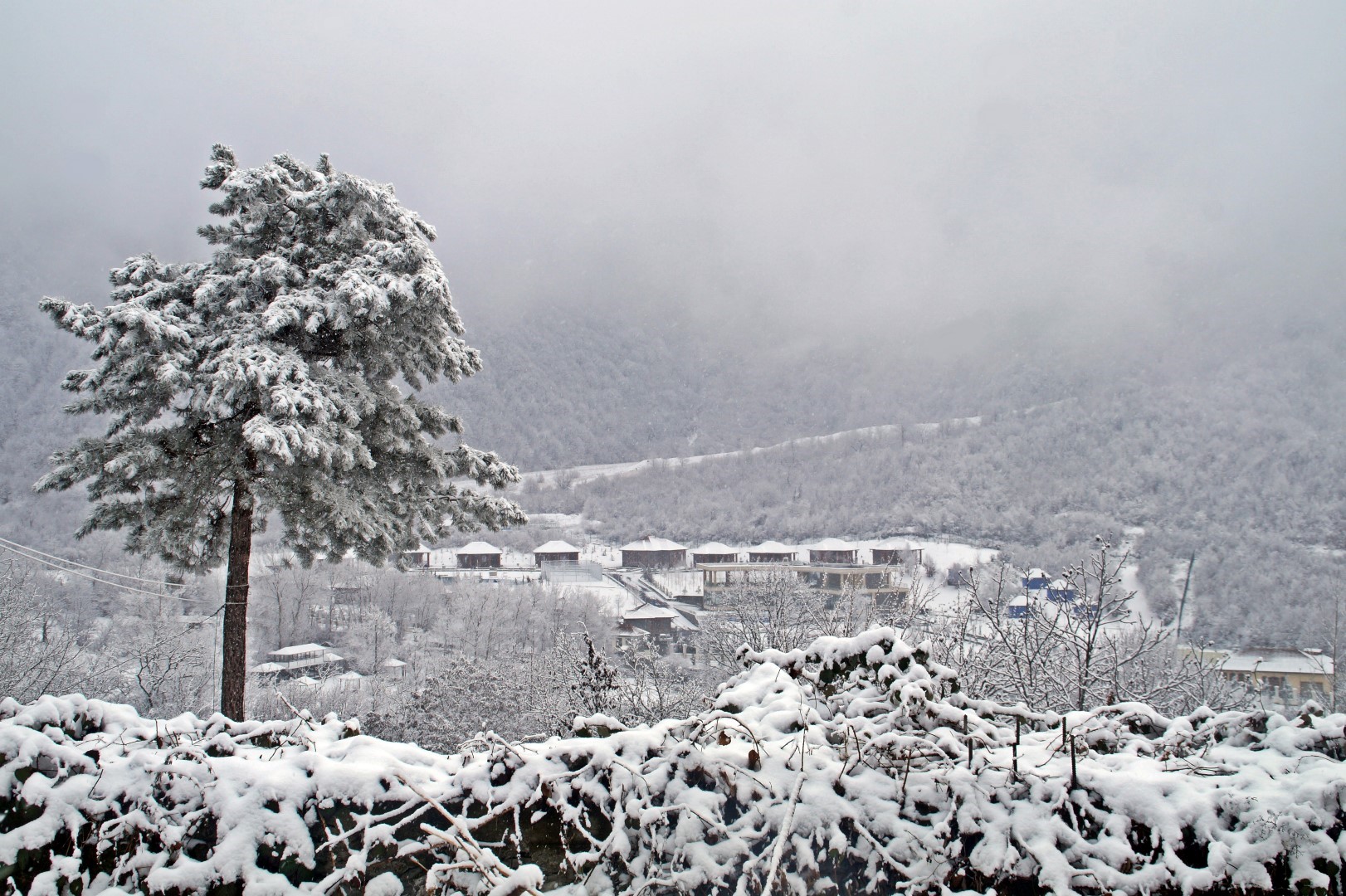
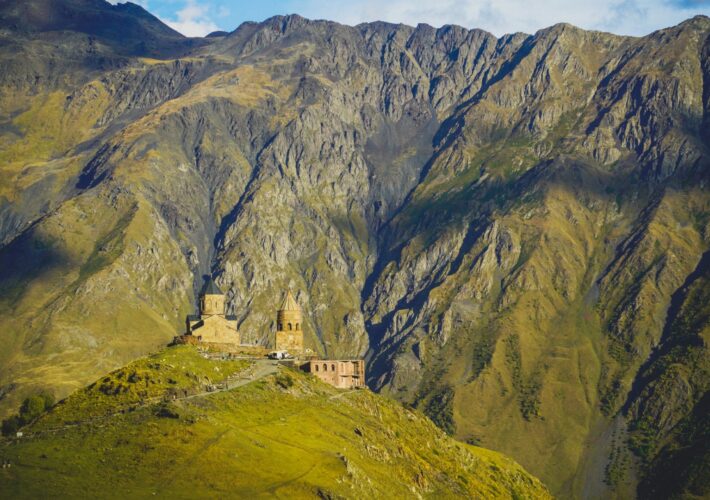
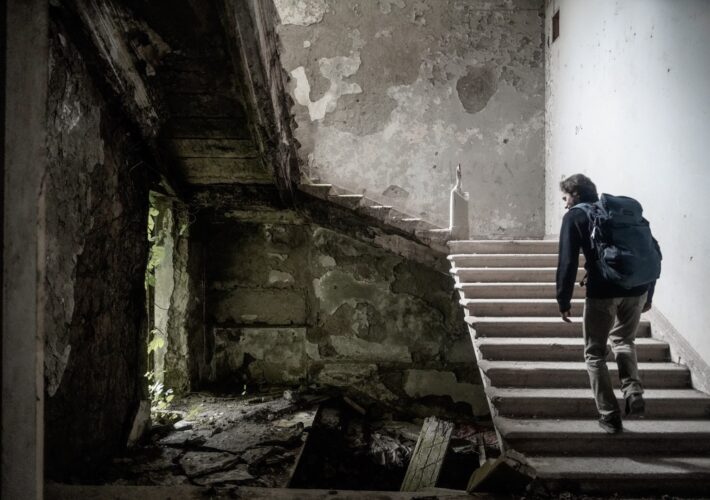
5 COMMENTS